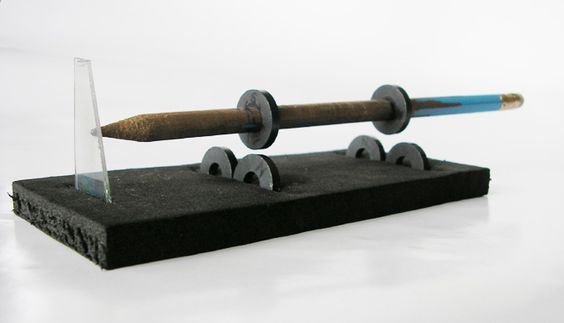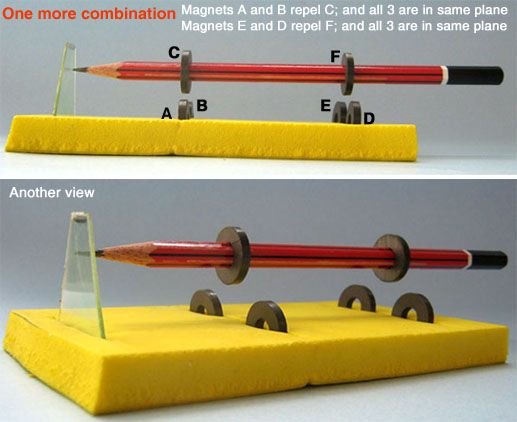Looking to entertain the kids, or impress your adult friends? Perhaps you are a teacher and you are looking for an experiment that demonstrates how magnets work, and why they do what they do! This little bit of science blew my mind, and I am sure it will have an effect on your viewers and participants too! You could pass it off as a cool magic trick, even though there is sound reason as to why the pencil “levitates” the way it does.
I know from experience that kids love playing with magnets, which come in all sorts of shapes and sizes. While they enjoy the hours of fun they get from them, they might know what a magnet is exactly, or how they work. This demonstration will help them to grasp the concept, especially if it accompanies just a tad bit of theory, for instance:
Five Interesting Things You Should Know About Magnets:
- Magnets have two opposite ends, which are referred to as poles. The poles on one end care called a north pole or north-seeking pole, while the other end is called a south pole or south-seeking pole.
- Each of these opposite ends attract it’s opposing pole.
- An invisible magnet field surrounds a magnet.
- The north pole of a magnet points closely towards the Earth's north pole and the southern pole of a magnet points towards the Earth’s southern pole, this is because the Earth itself has enough magnetic materials in it to be considered one enormous magnet.
- You can turn an unmagnetized piece of iron, like an iron screw, into a magnet by simply running a magnetised object over a few times, this process is called magnetization

Experiment: Make Your Pencil Levitate
This very quick and easy science experiment is an excellent way to use a visual aid to explain how opposite poles of a magnetic attract, while the same poles repel each other. To do this nifty “trick”, you will need the following items:
- A pencil
- Six round magnets with holes in the center (big enough for your pencil to fit through)
- A piece of foam
- Sticky tape
Instructions:
- Take your pencil and wrap some sticky tape around the two opposite ends.
- Work your pencil through the holes of two round magnets and then let each of the magnets rest on one of the sticky taped sections.
- Make four holes in your piece of foam, for the other for magnetic to be placed in to. The magnets in the foam need to be spaced out to match the spacing of the magnets on the pencil (see image below as an example).
- Take your piece of plastic (CD case covers work well) and pierce it into your foam board, at one of the ends.
- Take the pencil with the magnets and place it over the four magnets on the foam board, with the sharpened side of the pencil touching the plastic divider.
- Watch as the pencil hovers in the air!

The Science Bit
These magnets are repelling each other.
The rule to remember is that opposites attract. Every magnet has both a North and a South pole. When you place the North pole of one magnet near the South pole of another magnet, they are attracted to one another. When you place like poles of two magnets near each other (North to North or South to South), they will repel each other. - https://www.kjmagnetics.com/blog.asp?p=magnet-basics
This experiment is safe for kids to do at home, they materials are also very simple and affordable, the magnets can be purchased from your local hardware store. Activities like this make you realise that kids don’t need the plastic and shiny toys found on shelves these days, they just need a box of odds and ends, AND SCIENCE!
We love science, especially physics
Downvoting a post can decrease pending rewards and make it less visible. Common reasons:
Submit
your post is very interesting, I like your post, because it can add insight for me, hopefully the future can provide better posts again, so that I can know many things in my life, thank you @sweetpea
Downvoting a post can decrease pending rewards and make it less visible. Common reasons:
Submit
My kids will love this.
Hadn't thought to set up magnets with and a barrier to prevent the repulsion moving the object and thus allowing it to remain floating stationary.... cheers.
I'll try building this as soon as I've finished the marble run I've promised them :)
Downvoting a post can decrease pending rewards and make it less visible. Common reasons:
Submit
very good post
Downvoting a post can decrease pending rewards and make it less visible. Common reasons:
Submit
@sweetpea, Great Informative Article. I also have tried to levitate the pencil at home via an experiment.....but with no success. But yours is an excellent step-by-step approach to help one succeed in levitating the pencil. I am sure gonna try this again.
Thanks for the great info. I just upvoted the post. You can follow me @drvnpatel. Being a person from science background, I also like to post interesting stuff like this.
Downvoting a post can decrease pending rewards and make it less visible. Common reasons:
Submit
uhh, that looks so cool.... we have a tonne of neodynium magnets that we use to hold things up on the fridge and simply cause we like the way they behave, then don't have any holes in them though... hmmm I wonder if there is a way to make this work without the holes? Maybe something flat and you attach the magnets to the bottom of it?
If I manage to make it work I will do a post and link it here. The feegles (2 and 4 yrs old) would love it!
Downvoting a post can decrease pending rewards and make it less visible. Common reasons:
Submit
Cool post! I love messing around with magnets :)
Downvoting a post can decrease pending rewards and make it less visible. Common reasons:
Submit